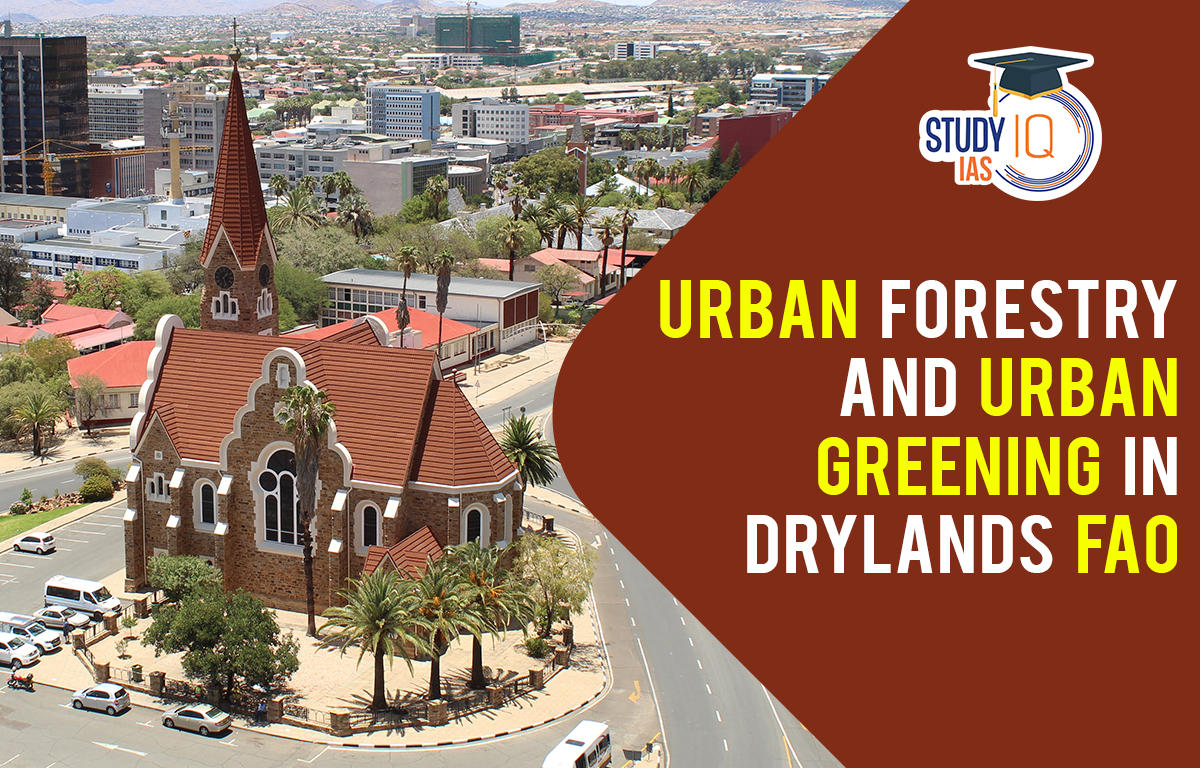Table of Contents
About Urban Forestry and Urban Greening in Drylands: FAO
The report was produced in the framework of FAO’s Green Urban Oases Programme, launched to improve the resilience of dryland cities by tackling climate, health, food and economic challenges.
- The program contributes to FAO’s Green Cities initiative that was launched in 2020 to improve the livelihoods and well-being of urban and peri-urban populations in at least 100 cities around the world in the next three years.
Highlights of the Report
- Some 35% of the world’s largest cities (including New Delhi, Cairo etc.) are built in the world’s drylands facing a high risk of social, environmental and economic crises as they grow.
- Scarce rainfall and water supplies compound the negative impacts of rapid urbanization on drylands, leading to overexploitation of limited resources, increased land degradation etc.
- Urban forestry and greening strategies have yet to be fully incorporated in many dryland cities.
Drylands
- They are regions in which the aridity index (the ratio of annual precipitation and mean annual potential evapotranspiration) is not more than 0.65.
- Drylands are commonly categorized according to an aridity gradient – hyper arid, arid, semiarid and dry sub-humid – and are referred to as arid or desert lands.
- Drylands make up 41 percent of the Earth’s land surface, housing about 2 billion people, of whom 90 percent live in developing countries, mainly in Africa and Asia.
Recommendations
- At landscape level: Plan and maintain green spaces and select trees and other plants that are suited to local environment and cityscape.
- At community level: Boost community participation and a sense of ownership, also to provide incentives to encourage tree planting and building capacity through environmental education.
- At governmental level: Create robust policies and protect urban greenery.
Need for Urban Forestry
- Increasing Urbanisation: Since 1950, urbanization has been rapidly increasing. Today, more than half of the global population lives in cities.
- The urbanization rate is growing fast, especially in the global South, where 95 per cent of the urban growth projected from now up to 2050 is expected to occur.
- Dryland Challenge: Some of the world’s most vulnerable ‘populations, i.e. people living in drylands, face particularly daunting challenges.
- Rapid urban growth in drylands areas results in overexploitation of already limited resources increases land degradation and exacerbates the vulnerability of urban communities
Dryland Cities Vulnerability
- Climate change: It is estimated that climate change will severely reduce food production and livelihood opportunities by limiting access to water, food and fuelwood.
- Impact: Increasing poverty and health risks in rural drylands, which is likely to be reflected in an increase of rural-to-urban migration.
- Vulnerability of urban populations to health-related problems in drylands: Exposure to high temperatures can have direct and indirect negative impacts on the health of populations of dryland cities.
- It can provoke mild conditions, such as cramps, fainting and exhaustion, as well as more acute conditions, such as heatstroke, which can lead to permanent damage or even death
- Air Pollution: Cities in drylands generally have a large concentration of air pollution, with a significant proportion of particulate matter (PM) coming from desert dust and sandstorms
- Dust particles and dust storms are associated with a higher rate of respiratory and cardiovascular diseases.
- Scarce rainfall and water supplies: They compound the negative impacts of rapid urbanization on drylands, leading to overexploitation of limited resources, increased land degradation and greater fragility for urban communities.
- This is particularly true in hot drylands, where high temperatures and projected temperature increases will more significantly affect evapotranspiration.
- Public Health Burdened: With temperatures rising due to climate change, the effects are particularly acute in an urban setting, resulting in higher rates of respiratory and cardiovascular disease, with air pollution as an exacerbating factor.
- Increased demand for food and basic services as a result of soaring urbanization is exerting severe pressure on already stressed infrastructure and natural resources in many dryland cities, with major social, environmental and economic repercussions.
- Lack of appropriate governance: unprecedented growth of cities, particularly in developing countries, leaves municipalities with little time to adjust to constant urban changes and pressures while struggling to harmonize the goals, actions and needs of different agencies.
Urban Forestry: Solution for Drylands Challenges
- Tree planting in urban drylands shows potential for transforming arid cities from climate-vulnerable areas into valuable examples of sustainability, resilience and climate action in urban areas.
- Incorporating green spaces, trees and forests into the urban fabric can support the provision of ecosystem goods and services that are critical for the livelihoods, health and well-being of urban populations, while increasing their resilience to global shifts, such as climate change.
- Urban forests can perform three health-related functions:
- disease prevention;
- therapy; and
- recovery from illness.
Urban Forest
- It encompasses the trees and shrubs in an urban area, including trees in yards, along streets and utility corridors, in protected areas, and in watersheds.
- Urban forestry is the care and management of tree populations in urban settings for the purpose of improving the urban environment.
- It advocates the role of trees as a critical part of the urban structure, was developed to address the issue of impact on forestry by urbanization.
- The urban forestry comprises all green elements under urban influence.
- Trees have proven capacity to cool ambient temperatures – and adjacent buildings – clean the air, sequester carbon and contribute to soil and water quality, as well as increased biodiversity.
About Food and Agriculture Organization (FAO)
- FAO is a specialised agency of the United Nations that leads international efforts to defeat hunger.
- Established in 1945, the Food and Agriculture Organisation (FAO) has its headquarters in Rome, Italy.
- Objective: To provide food security for everyone and assure that people will have access to high-quality food in sufficient quantities to achieve a healthy lifestyle.





















 WhatsApp
WhatsApp